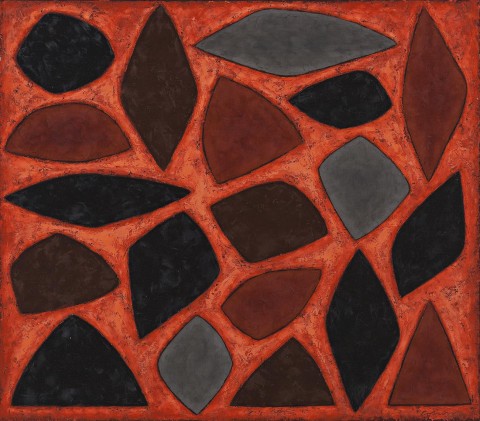DESERT COUNTRY, 1990
JOHN COBURN
oil on canvas
106.5 x 122.0 cm
signed and dated lower right: Coburn 90
signed, dated and inscribed with title verso: JOHN COBURN / “DESERT COUNTRY” … 1990
Private collection, Melbourne, acquired directly from the artist in March 1998
John Coburn, Greenhill Galleries, Perth, 27 August – 18 September 1991, cat. 5
Grishin, S., Accounting for Taste: The Lowensteins Arts Management Collection, Macmillan Art Publishing, Melbourne, 2013, p. 152 (illus.)
Highly evocative, John Coburn’s vision was forever reaching beyond the purely aesthetic. Bearing strong affinities with the work of Matisse, Rothko and Mirò, Coburn was inspired by the natural and spiritual worlds. His symbolic use of shape and colour was a language through which he explored the ancient, powerful features and tremendous spaces of Australia. Constantly sustained by this motivation across many decades of painting, a powerful wholeness in the oeuvre of Coburn emerged. Nadine Amadio describes Coburn’s progression as that of a pilgrim; 'a man who has been prepared to make a journey and return with the gifts of his insight’.1
Coburn’s recognition of the deep beauty of nature was ignited during his youth in the luminous and fertile hinterlands of Ingham, Queensland. And, in July of 1987, Coburn embarked on a journey from the top of Northern Territory down to Alice Springs. He was enthralled by the Central Australian desert, marvelling at the ancient rock formations and dramatic beauty of the vast wilderness. The expedition was a defining moment for the artist helping him to spiritually reconnect with the land he had formerly admired, his revived deep appreciation for the splendour and mystery of the desert becoming a prevailing subject in subsequent years.
Painted with a varied surface texture and tonal intensity, Desert Country, 1990 has a clear organic quality. Having now reached the peak of his success, Coburn was now to producing works with immense fluidity and creative freedom. As noted by Lou Klepac, Coburn during this period ‘had now reached a stage in his development as a painter where all influences and experiences merged, enabling him to establish a new and more private rapport with his paintings. He had mastered the complexities of the creative process and was no longer dependent on the demands of a particular style’.2 The rock shapes that adorn Desert Country, 1990, painted in dusky greys and earth reds, form a composition which is designed, yet seems graceful and effortless. Radiating passion and energy, Coburn’s symbols speaking eloquently of the land, much like the indigenous artists he had admired throughout his career.
Best known for his 1970 commission to design the Sydney Opera House tapestry curtains, Coburn’s personal language has endured. Through his many solo exhibitions, important commissions and prestigious awards, his commitment to his allegorical and sensory visions never wavered.
‘Appearances are distracting. What you feel about a thing is important, not what it looks like. I don't want to teach people to see. I want to get them to feel’.3
1. Amadio, N., John Coburn: The Paintings, Craftsman House, Sydney, 1988, p. 10
2. Klepac, L., John Coburn: The Spirit of Colour, The Beagle Press, Sydney, 2003, p. 92
3. The artist quoted in Klepac, L., John Coburn: The Spirit of Colour, The Beagle Press, Sydney, 2003, p. 33
MELISSA HELLARD
